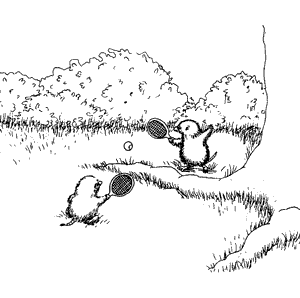Grass does not grow well in compacted soil. The spaces between particles of soil that normally store air and water are so compressed in compacted soil that little air or water is present. Microorganisms cannot reproduce and generate the nutrients needed by grass plants. Grass roots, seriously deprived of these vital elements (air, water, and nutrients), are badly stunted; the grass is stressed. There are a number of ways to determine if the soil under your turf is so seriously compacted that it needs to be repaired.
Screwdriver Test for Compaction
 |
Test for compaction by inserting a large screwdriver into the turf when the soil is dry. If it is hard to push the screwdriver down into the soil, that suggests a compaction problem. It is relatively easy to push a screwdriver into uncompacted soil that is dry.
Check Depth of Roots
If your soil is compacted the roots of the grass plants will be prevented from growing as deeply as they wish. Most turfgrasses will grow root systems 6 to 10 inches deep if the soil is good. Most yardeners have roots that go down only 2 or 3 inches; a sure sign of compacted soil. To check the root depth take a trowel and dig out a plug of your turf 5 or 6 inches deep. Now you can see the roots. If they go down all the way to the bottom of the plug, then you are probably in good shape. However, if the roots are visable down only 2 or 3 inches you now know you have a serious soil problem.
Is Soil Protected?
It may sound a bit ridiculous to ask whether the soil under your grass is protected from the environment. How can the sun and wind affect soil covered by turf? Well, this issue may not be quite so important for soil under grass as it is for soil under trees, shrubs, and in garden beds, but it still deserves your attention. Any soil exposed directly to the sun, wind, and rain is adversely affected and is under stress from that environment.
THE SIMPLE RULE IS THAT THERE SHOULD BE NO BARE SOIL ANYWHERE ON YOUR ENTIRE PROPERTY!
If the grass over your soil is not very dense, then the sun's rays can reach the dirt and dry it out. The wind then blows the dust away causing minor erosion. Similarly, rain can hit the exposed soil and cause slow but steady compaction. Look beyond your lawn to those areas under trees and shrubs growing in the yard, maybe in the turf. Is the soil under those plants bare or almost bare? If so, it is suffering from the elements.
Soil under trees and shrubs should always be mulched if it is not covered by grass. Of course, growing grass under trees and shrubs is almost a hopeless task. Here again is another good reason to leave your clippings on the lawn as you mow. Those clippings serve as a mulch for the soil, protecting it from the impact of sun, wind, and rain.
Look For Tree Surface Roots
 |
Perhaps one of the most obvious indicators of serious soil compaction is tree roots that are exposed in the lawn. Normally a tree's feeder roots range through the top 4 to 6 inches of soil seeking air, water and nutrients. This is, of course, exactly the same area where the grass roots are looking for nutrients, air and water. The limited amount of air in compacted soil not only stunts grass roots, but it forces tree roots to come toward the surface of the soil in search of oxygen. So the presence of tree roots bulging above the soil surface signals compaction of the soil. See the file Dealing With Surface Tree Roots for help in solving that particular problem.

